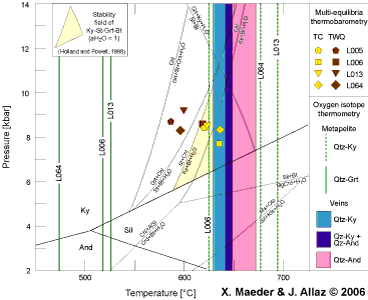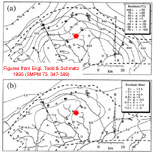Tectonic and metamorphic evolution of Simano nappe at Alpe Larecc (Tessin, CH) © 2003-2007, Uni. Lausanne (Switzerland).
Contacts: Xavier MAEDER (maederx@uni-mainz.de) or Julien ALLAZ (jallaz@geo.unibe.ch)
Page address... http://larecc.geoloweb.ch/fr/index.php?page=diplome_3 .......... Printed the 25.04.2024 at 22:32
| 2) Structural | 3) Thermobarometric Study | 4) Knauern |
| The degree of metamorphism* is characterized by a mineral assemblage* (see first page). Minerals forming a metamorphic assemblage are by definition in equilibrium. This equilibrium is characterized by various parameters notably rock and minerals chemistry, presence of fluids, pressure and temperature. This equilibrium generally corresponds to a maximum of temperature, point called "metamorphic peak". |
We apply on diagnostic metamorphic assemblage the method known as "multi-equilibrium thermobarometry*". On the basis of mineral chemistry, thermodynamic laws and database, equilibria (or "reactions") can be computed and they should intersect in one point, if equilibrium is achieved. |
|
| More info on the web: TWQ (R. Berman), Practical aspect of Mineral Thermobarometry (D. J. Waters), THERMOCALC (T. Holland and R. Powell) | ||

Pressure-Temperature results for micaschists of Alpe Larecc And comparaison with temperatures estimated by oxygen isotops thermometry (on mineral pair quartz-aluminosilicates). Errors not represented on figure: maximum ±1 kbar, ±50°C for TWQ and TC; ca. 50°C for oxygen isotope thermometry. |
The thermobarometric study has been done by comparison of two different thermodynamic databases for mineral, THERMOCALC 3.1 (Holland & Powell 1998 [reference] - 2002 [web]) and TWQ 2.02 (Berman 1988 [reference] - 1997 [web]). These two databases allowed a quantification of equilibrium (P and T) in micaschist* and paragneiss* (all rocks are composed notably of garnet, staurolite and kyanite) at about 620 to 650 °C and 8 to 10 kbar (= 0.8 to 1 GPa, 20 - 25 km depth). These conditions are coherent with the mineralogical assemblage (triangle of coexistence of garnet, staurolite, biotite and Kyanite in figure on the left). The TWQ results show temperatures slightly lower (of about 50°C), but comparable pressures. |
The estimated temperatures are slightly higher than those determined by Todd & Engi (1997 [reference], figure above). However, Todd and Engi have worked with the first version of TWQ. Using this TWQ version with our analyses gives comparable temperature but lower pressure (1-2 kb lower, results not presented here). |
|
|
Another method of thermometry is based on the determination of oxygen isotopic ratio (16 and 18, "d18O" method) of some mineral couple to allow calculation of an equilibration temperature. This method has been used on minerals of tension gashes (aluminosilicate-bearing quartz vein or "Knauern") for which one mineral assemblage is not sufficient for P-T determination with a conventional thermobarometry study. Mineral pairs used are quartz-kyanite and quartz-andalusite. A comparison has been done with three other surrounding rocks with quartz-kyanite and quartz-garnet pairs. |
In both cases (tension gashes and surrounding rocks), the pair quartz-aluminosilicates give temperatures comparable to these determined for metamorphic peak of temperature (600-650°C). At such temperature and a pressure higher than 3 kb, the presence of andalusite is doubtful. Thus this mineral has probably been formed lately during the retrograde* path (polymorphic* transformation kyanite => andalusite, with conservation of isotopic ratio, complete discussion in our publication [reference]). Finally, the pair quartz-garnet give temperatures of about 500-540 °C, which can be interpreted as point of mineral formation or an average between the beginning and the end of crystallization. |

Results of temperatures obtained by oxygen isotope thermometry (Method, calibration : Sharp 1992, 1995) |
1) Introduction | 2) Structural | 3) THERMOBAROMETRY | 4) Tension gashes | 5) Cartography | Bibliography | Thanks
Aluminosilicate-bearing veines: 4.1) Mineralogy | 4.2) Structure | 4.3) Examples | 4.4) Formation
| Info on copyright || Download the abstract | the publication (PDF) |
This work is copyright protected (info under http://larecc.geoloweb.ch/eng/copyright.php).
Please, quote the authors and this work if you want to use the entire or a part of this web site. Thank you in advance!
